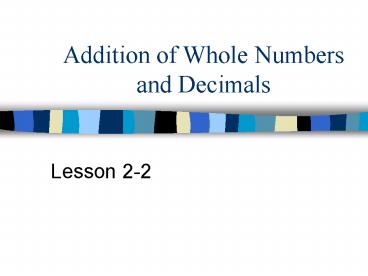Addition of Whole Numbers and Decimals PowerPoint PPT Presentation
Title: Addition of Whole Numbers and Decimals
1
Addition of Whole Numbers and Decimals
- Lesson 2-2
2
Objectives
- To review place value concepts and the use of
partial-sums and column addition. - Write numbers in expanded notation
3
Mental Math
- Expanded form means taking numbers apart by their
place value. - For example 25 would be 20 5, taking the tens
and the ones apart. - Another example 0.351 would be
- 0.3 0.05 0.001
4
Mental Math Write the following numbers in
expanded form. Number your piece of paper 1 - 8
- 0.52 0.5 0.02
- 52 50 2
- 0.35 0.3 0.05
- 35 30 5
- 467 400 60 7
- 0.241 0.2 0.04 0.001
- 241 200 40 1
- 162 100 60 2
5
Math Message
- You need your SRB Student Reference Book.
- Turn to page 28 30.
- Use these pages to answer the Check Your
Understanding Problems on the bottom of page 30. - As you work, think about one true statement that
could be made about the base-ten system for
numbers.
6
Now that youve read the SRB
- Look at the place value chart on page 30 of your
SRB. - Look over the headings on the chart.
- Describe any patterns you see.
7
Here are some patterns you might have noticed
- The numbers decrease in size from left to right.
- The columns on the right side of the chart have a
decimal point and the left side does not. - The zeros 0s increase by one for each column as
you move outward from the center in either
direction.
8
Math Message Follow Up
- Each place has a value that is 10 times the value
of the place to its right. - For example, 1,000 is 10 times as much as 100
- 100 is 10 times as much as 10
- 10 is 10 times as much as 1
- 1 is 10 times as much as 0.1
- 0.1 is 10 times as much as 0.01
9
Check out how the numbers line up.
- 0.01 x 10 0.1
- 0.1 x 10 1.0
- 1.0 x 10 10.0
- 10 x 10 100.0
- 100 x 10 1,000.0
10
Whats the opposite of multiplication?
- Division of course.
- Each place has a value that is one-tenth the
value of the place to its LEFT. - For example
- 100 is 1/10 of 1,000
- 10 is 1/10 of 100
- 1 is 1/10 of 10
- 0.1 is 1/10 of 1
- 0.01 is 1/10 of 0.1
11
Division of numbers by 10s
- 0.01 x 10 0.1
- 0.1 x 10 1.0
- 1.0 x 10 10.0
- 10 x 10 100.0
- 100 is 1/10 1,000.0
PowerShow.com is a leading presentation sharing website. It has millions of presentations already uploaded and available with 1,000s more being uploaded by its users every day. Whatever your area of interest, here you’ll be able to find and view presentations you’ll love and possibly download. And, best of all, it is completely free and easy to use.
You might even have a presentation you’d like to share with others. If so, just upload it to PowerShow.com. We’ll convert it to an HTML5 slideshow that includes all the media types you’ve already added: audio, video, music, pictures, animations and transition effects. Then you can share it with your target audience as well as PowerShow.com’s millions of monthly visitors. And, again, it’s all free.
About the Developers
PowerShow.com is brought to you by CrystalGraphics, the award-winning developer and market-leading publisher of rich-media enhancement products for presentations. Our product offerings include millions of PowerPoint templates, diagrams, animated 3D characters and more.

